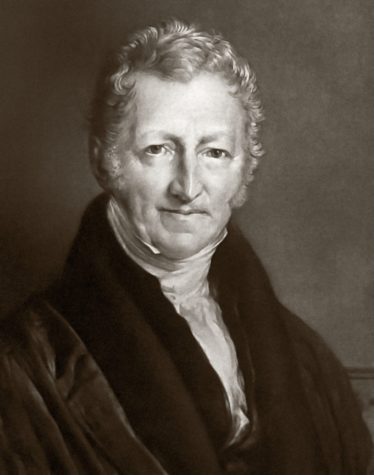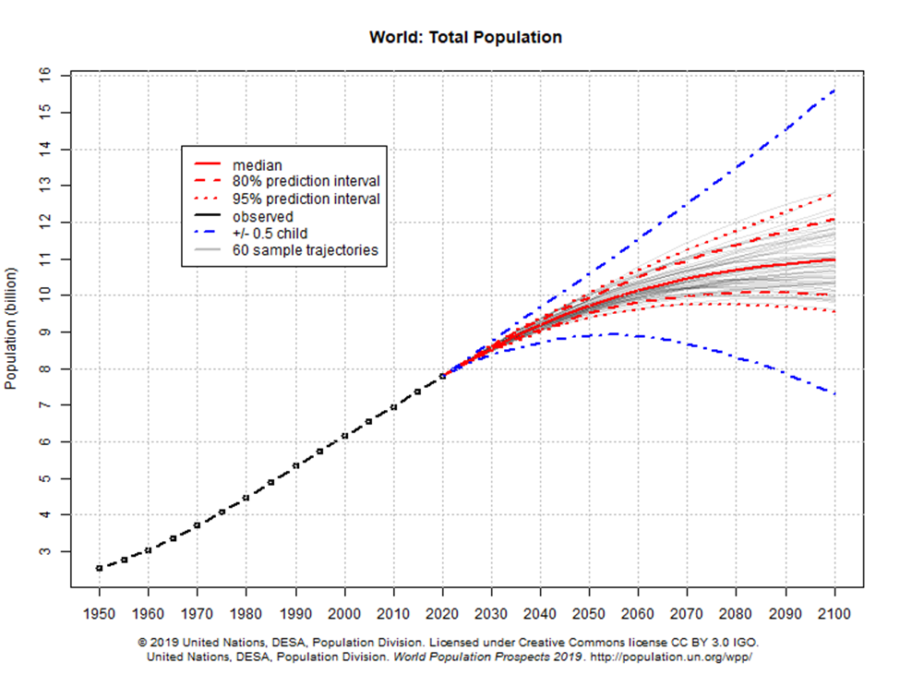Cheaper by the Dozen: What Reaching 8 Billion Means for Humanity
Despite long-held anxieties about population growth, experts are optimistic about our future demographics.
United Nations Population Division, CC BY 3.0 IGO
Current United Nations estimates have the human population reaching a maximum between 10 and 12 billion before the year 2100. However, there is some variability in these projections, as there will be many unforeseen factors.
November 15th, 2022: the Day of Eight Billion. That was the title bestowed onto this particular day by the United Nations, in order to commemorate the newest milestone in the growth of the human population. Impressively, the world only reached 7 billion people in 2011. Of course, the reality is that the true Day of Eight Billion might have been the previous day, or perhaps a month before or after . Many people are unaccounted for in censuses, so experts can only estimate exactly how many people live on Earth. Regardless, the occasion is as good as any to take a look at how we got here and where humanity is headed.
Circa 1804, the human population reached 1 billion. Amazingly, this was before the Industrial Revolution, which brought incredible advancements that changed the ways in which people lived, had reached most of the world. As such, the number of people on Earth only exploded thereafter, with developments in medicine and quality of life making it so that more people lived to reproduce. Extended lifespans meant that there were more people alive at any given time. According to a United Nations report, life expectancy at birth reached nearly 73 years in 2019, and while this number has slightly dropped since the COVID-19 pandemic, it still represents a massive increase from just a few decades ago. While the entire world has seen an increase in life expectancy, these changes are not distributed evenly. Per the World Bank, Japan has the highest life expectancy of any country at 85 years at birth, while nations such as Chad and Nigeria only approach 53 years.
Due to increased lifespans, the proportion of the world population that is elderly is projected to increase significantly in the coming years. Combined with low fertility, with two-thirds of people living in places where birth rates are below replacement levels, humanity is expected to undergo a stark demographic shift. This has led to fears of a world with too many elderly people, who are often unable to work, and too few young people to take care of them. However, anxieties about demographics are nothing new.
One of the earliest works on demography was An Essay on the Principle of Population, written by English cleric Thomas Malthus. In this monumental essay, Malthus argued that while the population increased exponentially, resources could only increase linearly. Therefore, at some point, there would be more humans than resources to provide for them, leading to disasters such as disease and famine unless birth rates decreased. The fact that Malthus described concepts such as carrying capacity and the struggle to survive over 60 years before Charles Darwin published On the Origin of Species is impressive. Still, what Malthus failed to grasp was that a greater population also meant more minds to develop means of greater resource yields. Since the publishing of his essay, the human population has grown eightfold, along with simultaneous improvements in living conditions, casting doubt on his rather pessimistic claims.

Even though Malthus’ specific predictions did not manifest, it did not stop other thinkers from borrowing Malthusian concepts to describe population growth. This ideology is typically called Neo-Malthusianism, holding that population planning is necessary to guarantee a sufficient supply of resources and a healthy environment. An important difference between Neo-Malthusianism and the original ideas of Malthus is that Neo-Malthusianists often advocate for contraception to achieve population control, while Malthus, a devout Christian, believed that people should engage in abstinence. One such application was by John Maynard Keynes, the influential economist, who referenced Malthusian pressures in his analysis of a war-torn Europe in his 1919 book, Economic Consequences of the Peace. Keynes argued that the Treaty of Versailles was too harsh on a postwar Germany that was set to experience a Malthusian crisis in the coming years. It can also be said that modern-day “doomer” culture on the internet, which has captured the minds of many terminally online young people with little faith in current institutions to make the changes necessary to survive, simply represents a continuity from the Malthusian thoughts of yore. However, the most consequential use of Malthusian concepts was yet to come.
In 1968, Paul Ehrlich’s The Population Bomb was published, warning readers of a coming “mass starvation.” An entomologist by trade, Ehrlich was distressed by the ecological impact of humanity and viewed population control as the only way to prevent further environmental degradation. Initially, the book failed to gain traction , but after Ehrlich’s 1970 appearance on Johnny Carson’s The Tonight Show, it took the world by storm. Over two million readers were horrified by Ehrlich’s vivid descriptions of an apocalyptic future in which the total collapse of society and the environment would occur. Spurred by their newfound fear of overpopulation, developing countries around the world engaged in campaigns to reduce fertility, including forced sterilization. In fact, it was these fears of overpopulation that inspired China’s one-child policy, which lasted from 1980 to 2015.
It is important to note that the catastrophe described by Ehrlich never happened. In reality, the world population has grown by over four billion, while the number of people who have died due to famine has actually become a fraction of what it was at the time. Ehrlich, still alive at 90, continues to campaign for the cause of population control, claiming that an increase in the death rate is still yet to come. However, experts today largely disagree with his prognosis, even if there are significant challenges to address.

Researchers believe that the greatest threat to the human population is climate change, which has already caused massive environmental instability and will only worsen should it not be combatted. Rising sea levels and an increased frequency of natural disasters will make life harder for everyone, particularly those in coastal and low-income communities. These disasters can lead to resource shortages globally , with impacted areas potentially unable to export goods. Reducing these dangers will require a drastic change in our behavior, with harmful fossil fuels currently making up 80% of all energy production. Fighting climate change will go a long way toward ensuring that the planet can sustain 8 billion people.
Other steps in addressing population growth are more societal. Economic inequality remains a pressing issue, which in turn affects public health and other important concerns. With poverty being strongly associated with shorter lifespans, it is important that going forward, action is taken to reduce inequality. Further, society’s current emphasis on production and consumption as a metric of success will need to be adjusted, as this mindset entirely ignores the social and environmental impact that such behavior can have. By engaging in more sustainable consumption, any ills that may come as a result of population growth can be mitigated.
Regardless of any external threats, the human population will likely stop growing in the near future. As more of the world experiences development, improved access to birth control and education, especially for women, will lead to lower birth rates, as has already occurred in much of the world. Despite areas such as Africa and South Asia only beginning to experience this growth, this has already begun to take shape, with humanity experiencing its lowest growth rate since 1950. Current United Nations estimates have the human population reaching a peak of 10.4 billion in the 2080s before stagnating until 2100, at which point there would be a slight decrease.
It is important to face the future of humanity with both optimism and pragmatism. While there is nothing to fear about population growth or decline in and of itself, appropriate action must be taken to ensure a safe and equitable future for all.
By engaging in more sustainable consumption, any ills that may come as a result of population growth can be mitigated.
Lucas Melendez is an Arts & Entertainment Editor for ‘The Science Survey.’ He believes that journalistic writing is a vital means of communication,...

